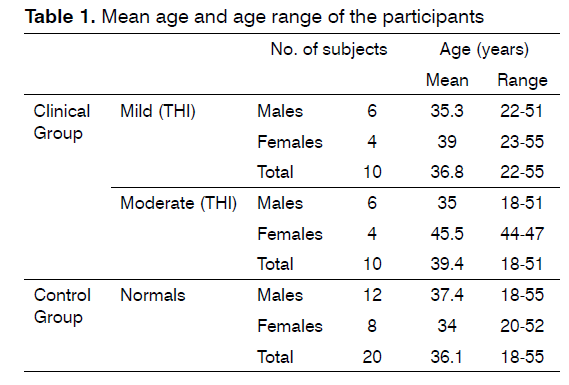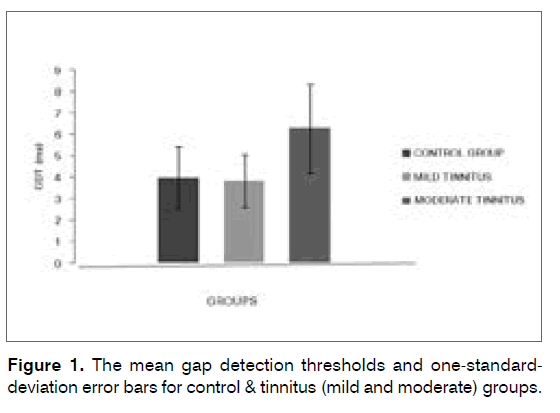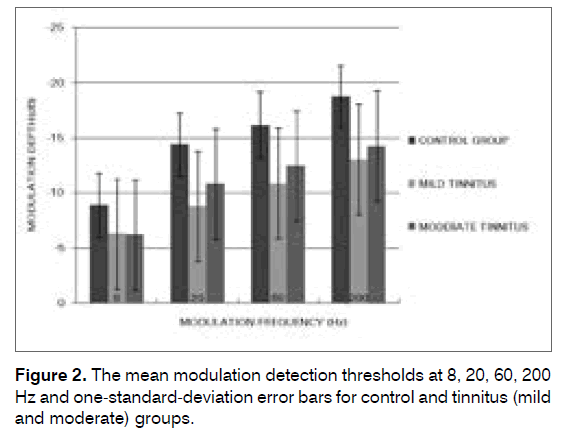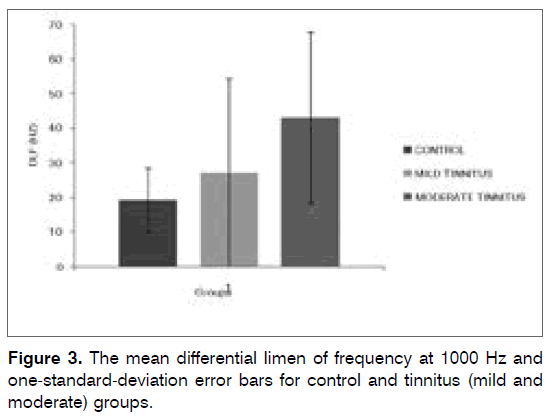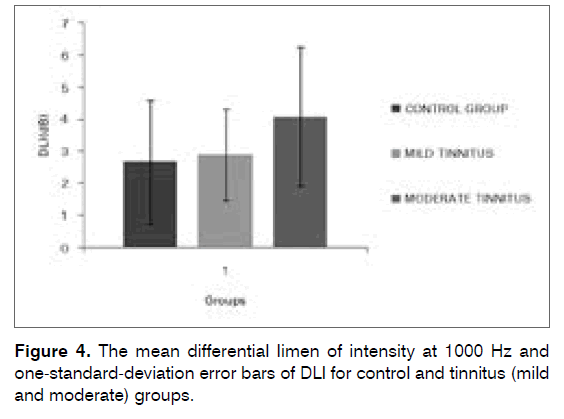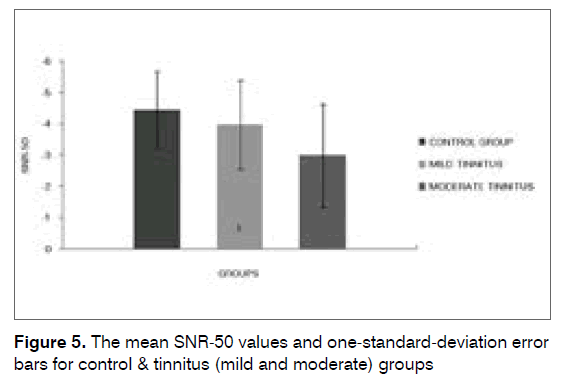The International Tinnitus Journal
Official Journal of the Neurootological and Equilibriometric Society
Official Journal of the Brazil Federal District Otorhinolaryngologist Society
ISSN: 0946-5448

Google scholar citation report
Citations : 12717
The International Tinnitus Journal received 12717 citations as per google scholar report
The International Tinnitus Journal peer review process verified at publons
Indexed In
- Excerpta Medica
- Scimago
- SCOPUS
- Publons
- EMBASE
- Google Scholar
- Euro Pub
- CAS Source Index (CASSI)
- Index Medicus
- Medline
- PubMed
- UGC
- EBSCO
Volume 19, Issue 1 / June 2014
Research Article Pages:28-35
The effect of tinnitus on some psychoacoustical abilities in individuals with normal hearing sensitivity
Authors: Chandni Jain; Jitesh Prasad Sahoo
PDF
Abstract
Introduction: Tinnitus is the perception of a sound without an external source. It can affect auditory perception abilities in individuals with normal hearing sensitivity. Purpose: The aim of the study was to determine the effect of tinnitus on psychoacoustic abilities in individuals with normal hearing sensitivity. Materials and Methods: The study was conducted on twenty subjects with tinnitus and twenty subjects without tinnitus. Tinnitus group was again divided into mild and moderate tinnitus based on the tinnitus handicap inventory. Data Collection and Analysis: Differential limen of intensity, differential limen of frequency, gap detection test, modulation detection thresholds were done through the mlp toolbox in Matlab and speech in noise test was done with the help of Quick SIN in Kannada. Results: Results of the study showed that the clinical group performed poorly in all the tests except for differential limen of intensity. Conclusions: Tinnitus affects aspects of auditory perception like temporal resolution, speech perception in noise and frequency discrimination in individuals with normal hearing. This could be due to subtle changes in the central auditory system which is not reflected in the pure tone audiogram.
Keywords: psychoacoustics, speech perception, tinnitus
Introduction
Tinnitus is an otologic symptom and it requires detailed audiological evaluation due to its numerous etiological conditions [1,2]. The existence of tinnitus could be due to the disrupted neural activity at the level of the auditory system or may be of cochlear origin [3,4]. Oxenham & Bacon [5] reported that even a minute cochlear disorder may affect the cochlear amplification mechanisms. Thus, tinnitus of cochlear origin might involve deformities of both cochlear function and the processing of tinnitus within the nervous system.
Studies have shown that tinnitus impairs speech perception in noise [6-8] and temporal perception [9-12]. Sanchez et al. [10] investigated temporal perception in individuals with tinnitus and normal hearing to find out the possible effect of subtle cochlear changes in the auditory perception. Results showed that temporal perception and speech perception in noise was impaired in these individuals.
Sanchez et al. [13] compared the results of the gaps in noise test in normal hearing subjects with and without tinnitus. Results showed that individuals with tinnitus detected silence gaps with larger time of interval than the non-tinnitus individuals; i.e. poor temporal processing in tinnitus population. They attributed this result to the subtle cochlear damage in individuals with tinnitus having normal hearing sensitivity. Similar results were obtained by Mehdizade Gilani et al. [12] who studied 20 subjects with tinnitus and reported that patients with tinnitus have temporal resolution difficulties in the Gap in Noise test, in spite of normal auditory thresholds. In another study by Haas et al. [11], poorer temporal acuity on gap detection threshold test in nine tinnitus subjects with normal hearing sensitivity was reported. However, Acrani & Pereira [9] in their study of 15 individuals with constant bilateral tinnitus with normal hearing reported of no significant difference in temporal resolution of individuals with and without tinnitus.
Speech perception abilities in quiet and noise have also been assessed in individuals with tinnitus, with and without hearing loss to find whether tinnitus contributes towards the commonly reported breakdowns in speech understanding. Newman et al. [14] investigated the relationship among psychoacoustic judgments, speech understanding ability and self-perceived handicap in subjects with tinnitus and hearing impairment. Audiometric speech measures were obtained for open set PAL = 50 PB-words in a quiet, closed set synthetic sentence identification, speech perception in noise and dichotic sentence identification. They reported in their results that tinnitus may interfere in the perception of speech signals which have reduced linguistic redundancy.
Huang et al. [15] conducted Mandarin Speech Perception in Noise Test (MSPIN) on 20 individuals with normal hearing sensitivity but had complaint of tinnitus. They reported significantly lower MSPIN score in their clinical group compared to the control group. Another study by Ryu et al. [8] similarly reported that tinnitus itself could adversely affect speech perception ability. Hennig et al. [7] evaluated speech recognition in the presence of competitive noise in normal hearing individuals with tinnitus and hyperacusis. The results showed a similar performance in the speech recognition in silence, but poorer performance on speech perception in noise in tinnitus patients when compared with normal-hearing individuals without complaints of tinnitus and hyperacusis.
Thus, the majority of the studies cited in the literature reported poorer speech perception abilities in individuals with tinnitus. The underlying basis for such complaints may be attributed to the interference to speech signals by either tinnitus or hearing loss which restricts the spectrum of sound available for higher level interpretation or a combination of the above two. It can also be hypothesized that subtle cochlear or neutral deficits in tinnitus patients might create deficits in various auditory abilities.
Studies have been conducted to investigate the impact of tinnitus on temporal characteristics and speech perception in noise. However the effect of tinnitus on other psychoacoustical abilities like frequency and intensity discrimination has not been studied. Additionally the effect of severity of tinnitus on these abilities has not been established. The perception of these psychoacoustic abilities plays an important role in the speech perception in noise. Frequency discrimination ability helps in the perception of stop consonants and in understanding frequency transition [16]. Intensity discrimination ability is important in understanding just noticeable differences in formants and in the discrimination of peak to valley differences in intensity. The role of temporal perception in speech perception is very well known; however, the role of other psychoacoustic abilities in speech perception is still not well understood. Thus, this study incorporates investigating the impact of tinnitus on all of these abilities in individuals with different degrees of tinnitus. It will help in understanding the way in which chronic tinnitus disrupts normal temporal characteristics, frequency and intensity discrimination as well as speech perception ability in noise.
Participants and Methods
The current study was designed to investigate the effect of tinnitus on the temporal characteristics of the auditory system, frequency and intensity discrimination and speech perception ability in noise in persons with normal hearing sensitivity.
Research Design
A cross-sectional descriptive research was used to accomplish the aim of the current study.
Participants
Two groups of participant were included within the age range of 18-55 years (mean age: 38.1 years) to fulfil the objectives of the study. The clinical group included 20 participants (12 males and 8 females) complaining of tinnitus, having normal hearing sensitivity. Tinnitus Handicap Inventory (THI) was administered to the clinical group to assess the severity of tinnitus and accordingly, the group was divided into a mild (score of 18-36 on THI) and a moderate (score of 38-56 on THI) subgroup for comparison. Thus, the clinicalgroup was divided into; mild tinnitus group (10 subjects; 6 males and 4 females) and moderate tinnitus group (10 subjects; 6 males and 4 females). Control group included 20 age-matched participants with normal hearing sensitivity and without tinnitus. The mean age and age range of subjects who participated in the study are depicted in Table 1.
The participants of the study had pure tone thresholds within 25 dB HL in octave frequencies from 250-8000 Hz for air conduction and 250-4000 Hz for bone conduction, ‘A’ Type tympanogram with acoustic reflex thresholds elicited at normal limits (90 dB at 1000 Hz). It was ascertained from a structured interview that none of the subjects had any difficulty in understanding speech in daily listening conditions and that they did not have any history of neurologic or otologic disorder. The subject’s participation was voluntary and they were not paid for their participation in the study. Ethical clearance was obtained from the relevant ethics committee at the institute prior to commencement of experimentation.
Procedure
Written consent was collected from all the subjects for willingly participating in the study. The subjects of both clinical and control groups were assessed for presence of hearing loss and middle ear pathology through pure tone audiometry and immittance audiometry. All the evaluations were done in one setting and by the same clinician. The whole assessment duration was for about one hour.
Tests to assess temporal resolution involved gap detection and modulation detection thresholds. Frequency discrimination was assessed through differential limen of frequency and intensity discrimination was assessed through differential limen of intensity. These tests were done by using Maximum Likelihood Procedure (mlp) toolbox. The mlp was implemented through Matlab by utilizing a large number of candidate psychometric functions [17]. After every trial, the program estimates the probability (or likelihood) of achieving the listener response to all of the stimuli that have been presented in that trial and determines the subsequent stimulus, considering the psychometric function which gives the highest probability. Within about 12 trials, the mlp generally attains a reasonably stable estimate of the most likely psychometric function. This is then used to estimate the threshold [18]. The stimulus for mlp is generated using 44,100 Hz sampling rate. In the present study a three-interval, alternate forced-choice (3-AFC) method using mlp was used to track a 79.4% correct response criterion. For all the tests, the subjects were given 5-6 practice items before the commencement of the test. The stimuli for the tests were presented using TDH 39 head phones, which was calibrated at 80 dB SPL.
Gap detection threshold
The gap detection threshold was assessed by obtaining the participant’s ability to detect a temporal gap embedded in the centre of a 500 ms broadband noise. The noise was designed to have a 0.5 ms cosine ramp at the beginning and the end of the gap. This broadband noise was used for the GDT as its spectrum didnot change with the insertion of the gap.
Modulation detection threshold
The modulation detection threshold was measured using a 500 ms Gaussian noise which was sinusoidally amplitude modulated at 8 Hz, 20 Hz, 60 Hz and 200 Hz modulation frequencies. The noise stimuli had 10 ms raised cosine ramps at the onset as well as the offset. The subjects were asked to say which block had the modulated noise. Modulated and un-modulated noise was equated to total root mean square (rms) power. The modulation depth was varied according to the subject’s response to track a 79.4% correct response criterion level. The modulation detection thresholds were expressed in dB by using the following relationship:
Modulation detection thresholds in dB = 20 log 10 m.
Where m = modulation detection threshold in percentage.
Difference limen of frequency
Difference limen for frequency for a 1000 Hz pure tone was measured using a three-block forced-choice procedure, through mlp procedure. On each trial, two of the three observation blocks contained pure tones at a reference frequency and one block selected at random, had a pure tone of variable frequency, which was always higher than the reference frequency. The participant’s task was to identify that block.
Difference limen of intensity
Difference limen of intensity for a 1000 Hz pure tone was measured using a three-block, forced-choice procedure. The rest of the procedure remained same as mentioned in DLF testing except that the variable in case of DLI was intensity.
Speech Perception in Noise
Speech perception in noise testing was done to measure understanding of 50% of the words in sentences (SNR-50). The subjects were presented with sentence lists developed for the Kannada Quick Speech in Noise test [19]. Each list contains 7 sentences mixed with 4-talker speech babble noise at different signal to noise ratio (SNR). The SNR in a list varied between + 8 dB to - 10 dB in 3 dB steps between each successive sentence. The signal and the noise were presented monaurally through a personal computer. The listener’s task was to repeat the sentences presented and each correctly repeated keyword was awarded 1 point for a total possible score of 35 points per list. The SNR-50 was calculated using the Spearman-Karber equation [20] as:
SNR-50 = I + ½ (d) - (d) (# correct)/(w)
Where,
I = the initial presentation level (dB S/B)
d = the attenuation step size (decrement)
w = the number of key words per decrement
# correct= total number of correct key words
Results
The main aim of the study was to determine the effect of tinnitus on temporal resolution, frequency discrimination, intensity discrimination and speech perception in noise, in individuals with normal hearing sensitivity. The data obtained was subjected to statistical analysis using SPSS software version 20.
Effect of tinnitus on temporal resolution
The temporal resolution of clinical and control groups was assessed through gap detection test and modulation detection test.
Gap Detection Test
Figure 1 shows the mean GDT scores for both the groups along with one standard deviation (SD) bar. In the figure, x-axis represents the various groups and the y-axis represents the gap detection threshold (ms). GDT scores reflect poorer performance by individuals with tinnitus compared to those without tinnitus.
To assess for the significance of GDT scores between control group, mild and moderate tinnitus groups, mixed ANOVA was done where the gap detection threshold was the dependent variable and severity of tinnitus was the independent variable. ANOVA results showed a significant main effect of severity of tinnitus on gap detection thresholds [F (2, 37) = 8.408, p < .001]. Boneferroni’s pairwise comparison showed no significant difference in GDT between control and mild tinnitus group (p > 0.05). However, GDT thresholds differed significantly between control vs. moderate groups and mild vs. moderate group (p < 0.05).
Modulation Detection Test
The MDT test was carried out for four different modulation frequencies (8, 20, 60, 200 Hz). Figure 2 represents the mean and SD of MDT at all the modulation frequencies for both control and clinical groups. In the figure x-axis represents the various groups at different modulation frequencies and the y-axis represents the modulation depth (dB). The figure shows that individuals without tinnitus had better MDT compared to those with tinnitus. Moreover, individuals with moderate tinnitus had the poorest MDT values followed by those with mild tinnitus, with the best thresholds obtained by those individuals without tinnitus.
Multivariate analysis of variance (MANOVA) was done to estimate the significant difference in mean thresholds of MDT across the control and clinical groups for the different modulation frequencies. The results of the analysis showed that there was a significant difference between both the groups which is given in Table 2.
Boneferroni’s pairwise comparison showed that there was a significant difference in MDT thresholds for all the modulation frequencies between control vs. Mild tinnitus group and control vs. Moderate tinnitus group (p < 0.05) except for the 60 Hz modulation frequency, which did not show a significant difference between control and moderate tinnitus groups. Also for all the modulation frequencies, there was no significant difference between mild and moderate tinnitus groups (p > 0.05).
Effect of tinnitus on frequency discrimination
The frequency discrimination ability was assessed using the differential limen of frequency at 1000 Hz. Figure 3 represents the mean and SD of DLF for both control and clinical groups. In the figure, x-axis represents the various groups and the y-axis represents the DLF in Hz. The figure shows that individuals without tinnitus had better DLF compared to those with tinnitus. Moreover, individuals with moderate tinnitus had poorest DLF values followed by those with mild tinnitus, with the best thresholds obtained by those individuals without tinnitus.
To assess for the significance of difference in DLF between control, mild and moderate tinnitus groups mixed ANOVA was performed keeping DLF threshold as dependent variable and severity of tinnitus as independent variable. ANOVA results showed a significant main effect of severity of tinnitus on DLF thresholds [F (2, 37) = 5. 090, p < .001]. Later Boneferroni’s pairwise comparison was done to assess if difference between the groups was statistically significant or not. Results showed that DLF differed significantly between control and moderate tinnitus groups (p < 0.05). However, there was no significant difference in DLF between control vs. mild and mild vs. moderate tinnitus groups.
Effect of tinnitus on intensity discrimination
Intensity discrimination was assessed using a differential limen of intensity at 1000 Hz. Figure 4 represents the mean and SD of DLI for both control and clinical groups. In the figure x-axis represents the various groups and the y-axis represents the DLF in dB. The figure shows that individuals without tinnitus had better DLI compared to those with tinnitus. Moreover, individuals with moderate tinnitus had poorest DLI values followed by those with mild tinnitus, with the best thresholds obtained by those individuals without tinnitus.
Mixed ANOVA was utilized to assess for statistical significance of DLI between control, mild and moderate tinnitus groups keeping DLI threshold as dependent variable and severity of tinnitus as independent variable. The results of the analysis showed that there was no significant main effect of severity of tinnitus on DLI thresholds [F (2, 37) = 1. 933, p > 0.001].
Effect of tinnitus on speech perception in noise
The SNR-50 was calculated to assess the speech perception performance in the presence of noise. Figure 5 depicts the mean and SD of SNR-50 values for all the groups. In the figure x-axis represents the various groups and the y-axis represents SNR-50 (dB). It is evident from the figure that people with tinnitus had poorer SNR-50 values compared to those without tinnitus.
Mixed ANOVA was used to determine the significance of difference in SNR-50 values between control, mild and moderate tinnitus groups keepingSNR-50 as dependent variable and severity of tinnitus as independent variable. The results of the analysis showed that there was a statistically significant main effect across groups [F (2, 37) = 3.770; p < 0.05] in SNR-50. Following that Boneferroni’s post hoc test was done to look for pairwise comparison. The results revealed that there was a significant difference in SNR-50 between control and moderate tinnitus groups (p < 0.05). However, there was no difference between control vs. mild and mild vs. moderate tinnitus groups.
Discussion
The findings of the current study indicate that individuals with moderate tinnitus need larger silent intervals to detect a gap within a noise than individuals with mild tinnitus as well as those without complaints of tinnitus. These findings are in agreement with previous studies [10-12]. However, in these supporting studies effect of degree of tinnitus on temporal resolution was not commented upon.
In a study by Fournier & Hébert [21] gap detection in individuals with tinnitus was assessed and they reported that the tinnitus group displayed a deficit in gap processing for both low and high background noise frequencies. They postulated that the reason for poor gap detection could be that ongoing tinnitus masks the gap and results in impaired gap detection. Sanchez et al. [13] used the Gap in noise test on normal hearing listeners to evaluate the auditory temporal resolution ability of 18 individuals with tinnitus and 23 individuals without tinnitus. They reported that individuals without tinnitus detected shorter gaps than individuals with tinnitus. Haas et al. [11] also reported of longer GDT in tinnitus subjects compared to non-tinnitus subjects and hypothesized that this could be due to some changes in neural activity in tinnitus patients.
In the current study, individuals with tinnitus needed greater modulation depth in comparison to individuals without tinnitus to detect a modulation in the noise in a wide range of modulation frequencies. This is suggestive of poor temporal resolution ability in the group with tinnitus. However, temporal processing ability to detect modulation was found to be similar across the different degrees of tinnitus. The effect of degree of tinnitus on MDT has not been studied earlier; hence this study adds to the existing literature of effect of tinnitus on psychoacoustic abilities.
Thus, the results of both GDT and MDT showed impaired temporal perception in clinical group compared to control group which is in accordance with the literature. The reason for the same could be due to defects in neural structures in the central auditory nervous system which has resulted in the perception of tinnitus, therefore also impairing temporal perception. However, the mild tinnitus group did not show a deficit in the GDT, whereas their MDT was poor. Thus, it could be postulated that MDT is a more sensitive tool to assess the effect of tinnitus on temporal resolution.
The results of the current study suggest that the ability to perceive speech in noise is affected in individuals with tinnitus compared to those without tinnitus. Similar findings have been reported in the past by various authors [7,8,14,15,22]. Furthermore, the speech perception ability in noise was not differing across the range of tinnitus severity.
Hennig et al. [7] evaluated speech recognition in the presence of competing noise in normal hearing individuals with tinnitus and without tinnitus and hyperacusis. They reported that both the groups performed similarly for speech recognition in silence, but poorer performance on speech perception in noise was seen in tinnitus patients when compared with normal-hearing individuals without complaints of tinnitus and hyperacusis. The reason for poorer speech understanding ability in the presence of noise could be attributed to the fact that tinnitus interferes with the speech perception. Also the role of the medial olivary cochlear system in the recognition of auditory stimuli in the presence of competitive noise [23,24] is well known and a disorder in this system is also hypothesized to cause tinnitus [23]. Thus, normal hearing individuals who have complaints of tinnitus may have a problem in certain communication situations due to a possible change in the functioning of the efferent fibres of the medial olivary cochlear system.
The present study showed that tinnitus had an effect on pitch discrimination ability, but the reduction in performance was similar irrespective of the severity of tinnitus. Intensity discrimination did not show any difference between control and clinical group. In the current literature, no other studies have assessed the effect of tinnitus on frequency and intensity discrimination and compared them to normal hearing individuals without tinnitus. The facts that pitch discrimination was poorer in individuals with tinnitus could be attributed to the subtle cochlear changes which is not evidenced in the pure tone thresholds. Intensity discrimination did not show any difference across the groups. This could be because DLI was done only for 1000 Hz. The pitch match of the tinnitus was not always at this frequency and this might have had an effect.
Conclusion
From the findings of the current study, it is concluded that tinnitus has an effect on certain aspects of auditory perception like temporal resolution, speech perception in noise and frequency discrimination in individuals with normal hearing. This could be due to subtle changes in the central auditory system which is not shown in the pure tone audiogram. These findings have a clinical significance in designing assessment and rehabilitation protocols for normal hearing individuals with tinnitus.
Acknowledgements
The authors would like to express gratitude to the Director, AIISH and HOD-Audiology for permitting us to carry out this research
The authors declare no conflict of interest.
References
- Lockwood AH, Salvi RJ, Burkard RF. Tinnitus. N Engl J Med. 2002;347(12):904-10. PMID: 12239260 DOI: http://dx.doi.org/10.1056/NEJMra013395
- Onishi ET, Fukuda Y, Suzuki FA. Distortion product otoacoustic emissions in tinnitus patients. Int Tinnitus J. 2004;10(1):13-6.
- Eggermont JJ, Roberts LE. The neuroscience of tinnitus. Trends Neurosci. 2004;27(11):676-82. DOI: http://dx.doi.org/10.1016/j.tins.2004.08.010
- Bartels H, Staal MJ, Albers FW. Tinnitus and neural plasticity of the brain. Otol Neurotol. 2007;28(2):178-84. DOI:http://dx.doi.org/10.1097/MAO.0b013e31802b3248
- Oxenham AJ, Bacon SP. Cochlear compression: perceptual measures and implications for normal and impaired hearing. Ear Hear. 2003;24(5):352-66. DOI: http://dx.doi.org/10.1097/01.AUD.0000090470.73934.78
- Killion M. New thinking on hearing in noise: a generalized articulation index. Sem Hear. 2002;23(1):57-75. DOI: http://dx.doi.org/10.1055/s-2002-24976
- Hennig TR, Costa MJ, Urnau D, Becker KT, Schuster LC. recognition of speech of normal-hearing individuals with tinnitus and hyperacusis. Int Arch Otorhinolaryngol. 2011;15(1):21-8.
- Ryu IS, Ahn JH, Lim HW, Joo KY, Chung JW. Evaluation of masking effects on speech perception in patients with unilateral chronic tinnitus using the hearing in noise test. Otol Neurotol. 2012;33(9):1472-6. DOI: http://dx.doi.org/10.1097/MAO.0b013e31826dbcc4
- Acrani IO, Pereira LD. Temporal resolution and selective attention of individuals with tinnitus. Pro Fono. 2010;22(3):233-8.
- Sanches SG, Sanchez TG, Carvallo RM. Influence of cochlear function on auditory temporal resolution in tinnitus patients. Audiol Neurootol. 2010;15(5):273-81. DOI: http://dx.doi.org/10.1159/000272939
- Haas R, Smurzynski J, Fagelson M. The effect of tinnitus on gap detection. Tinnitus Today. 2012;37(3):10,30.
- Mehdizade Gilani V, Ruzbahani M, Mahdi P, Amali A, Nilforush Khoshk MH, Sameni J, et al. Temporal processing evaluation in tinnitus patients: results on analysis of gap in noise and duration pattern test. Iran J Otorhinolaryngol. 2013;25(73):221-6.
- Sanches SG, Samelli AG, Nishiyama AK, Sanchez TG, Carvallo RM. GIN Test (Gaps-in-Noise) in normal listeners with and without tinnitus. Pro Fono. 2010;22(3):257-62. DOI: http://dx.doi.org/10.1590/S0104-56872010000300017
- Newman CW, Wharton JA, Shivapuja BG, Jacobson GP. Relationships among psychoacoustic judgments, speech understanding ability and self-perceived handicap in tinnitus subjects. Audiology. 1994;33(1):47-60. PMID: 8129680 DOI: http://dx.doi.org/10.3109/00206099409072954
- Huang CY, Lee HH, Chung KC, Chen HC, Shen YJ, Wu JL. Relationships among speech perception, self-rated tinnitus loudness and disability in tinnitus patients with normal pure-tone thresholds of hearing. ORL J Otorhinolaryngol Relat Spec. 2007;69(1):25-9. DOI:http://dx.doi.org/10.1159/000096713
- Ochs MT, Humes LE, Ohde RN, Grantham DW. Frequency discrimination ability and stop-consonant identification in normally hearing and hearing-impaired subjects. J Speech Hear Res. 1989;32(1):133-42. DOI: http://dx.doi.org/10.1044/jshr.3201.133
- Grassi M, Soranzo A. MLP: a MATLAB toolbox for rapid and reliable auditory threshold estimation. Behav Res Methods. 2009;41(1):20-8. DOI:http://dx.doi.org/10.3758/BRM.41.1.20
- Green DM. A maximum-likelihood method for estimating thresholds in a yes-no task. J Acoust Soc Am. 1993;93(4 Pt 1):2096-105. DOI:http://dx.doi.org/10.1121/1.406696
- Avinash MC, Meti R, Kumar U. Development of sentences for quick speech-in-noise (quicksin) test in kannada. J Ind Speech Hear Assoc. 2010;24(1):59-65.
- Finney DJ. Probit Analysis. Cambridge: Cambridge University Press; 1952. p.318.
- Fournier P, Hébert S. Gap detection deficits in humans with tinnitus as assessed with the acoustic startle paradigm: does tinnitus fill in the gap? Hear Res. 2013;295:16-23. PMID: 22688322
- Soalheiro M, Rocha L, do Vale DF, Fontes V, Valente D, Teixeira LR. Speech recognition index of workers with tinnitus exposed to environmental or occupational noise: a comparative study. J Occup Med Toxicol. 2012;7(1):26. DOI: http://dx.doi.org/10.1186/1745-6673-7-26
- Breuel ML, Sanchez TG, Bento RF. Vias auditivas eferentes e seu papel no sistema auditivo. Arq Fund Otorrinolaringol. 2001;5(2):62-7.
- Grataloup C, Hoen M, Veuillet E, Collet L, Pellegrino F, Meunier F. Speech restoration: an interactive process. J Speech Lang Hear Res. 2009;52(4):827-38. PMID: 18971288 DOI: http://dx.doi.org/10.1044/1092-4388(2008/06-0235)
References
Audiology - All India Institue of Speech and Hearing - Mysore - AC - India. E-mail: chandni_j_2002@yahoo.co.in/jitesh.aslp@gmail.com
Institution: All India Institute of Speech and Hearing, Mysore.
Send correspondence to:
Chandni Jain
Lecturer in Audiology, Naimisham Campus, AIISH, Mysore. Zip Code: 570006.
Paper submitted to the ITJ-SGP (Publishing Management System) on December 19, 2014; and accepted on March 16, 2015. cod. 183
Citation: Jain C, Sahoo JP. The effect of tinnitus on some psychoacoustical abilities in individuals with normal hearing sensitivity. Int Tinnitus J. 2014;19(1):28-35



